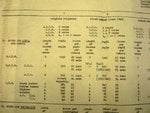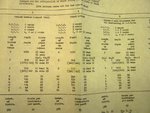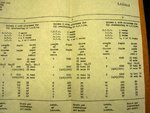Glider
Captain
All
There has been some debate about the actual training that RAF pilots received during the critical period leading up to and including the BOB.
I was able to go to the National Archives at Kew and found the file covering this topic. It was a substantial file and the attached is a summary which covers it nicely. I think its worth covering some of the key aspects in some detail and the chokepoints.
Its worth starting out with some numbers that show how difficult it was to deliver the training that was needed. In 1935 the RAF trained about 300 pilots a year, by the second revise in August 1940 this had increased to 7,000 pilots a year once the second revise was in place. With this kind of expansion you were going to have some problems along the way.
There were three types of training:-
EFTS - this was elementary training using aircraft such as the Tiger Moth
SFTS - Called Service Flight Training and this had two aspects ITS Initial Training and ATS Advanced Training. This used advanced trainers such as the Master
OTU - These introduced the trainee to front line aircraft and taught them how to fly and fight.
EFTS were often pre war flying schools that had been paid by the RAF to train pilots to a standard level. When war broke out they were incorporated into the RAF and expanded. However the transition was fairly simple, the core instrutors often had years of experience, new instructors were easily trained and everyone was familiar with the planes both pilots and engineers.
SFTS These schools were the choke points in the training process. The advanced trainers were few in number and couldn't be delivered quickly as the front line had the top priority for production capacity. The Instructors needed detailed schooling and were understandably in demand for the front line. The accident rate was heavy which is understandable if you have a shortage of aircraft being worked into the ground, ground crew often being asked to do other roles (such as guard duty) and trainees who by their nature are going to have more heavy landings etc, and increase the wear and tear on the aircraft.
Its worth noting that camera guns were used in the training at SFTS but no live firing. Comments have also been reported about training schools not working at maximum capacity during the BOB period. These were almost always made about the SFTS schools and the problem was you will have guessed, a lack of aircraft.
OTU - Initially these also had difficulties with aircraft. In the first few months of 1940 there were few Hurricanes to spare and almost no Spitfires for OTU. As a result fighter pilots often had to spend some of this time flying biplanes and bomber trainees Battles. Around May 1940 this had eased and Hurricanes were more common in the OTU.
This lack of modern fighters in the first few months probably explians why some pilots went to squadrons with a limited number of hours on Spitfores and Hurricanes
As you can see the problem was in the SFTS and mainly it was a lack of aircraft. A number of things were tried and in the second quarter a couple of the SFTS schools trialed the introduction of their trainees to Hurricanes before sending them to the OTU. The OTU were delighted as they didn't have to train the pilots how to fly the Hurricane, the pupils had confidence and they were able to concentrate on the business of teaching them the more advanced aspects of training.
The down side was a further increase in the accident rate at SFTS. As you can imagine these Hurricanes were older versions which had seen hard service, The already hard pressed ground crews at SFTS now had another type of aircraft to maintain which brought its own complications, plus these aircraft were worn out and needed more maintanence than average, throw in the fact the pilots were trainees and the problem is clear. The Hurricane took the rough handling quite well but there were a number of engine failures and the experiment was curtailed.
The attachments show the training at the start of 1940 and the amended schemes introduced during the year.
Most of it is pretty clear but there are a couple of things I should mention
a) You will see Group 1 and Group 2 mentioned Group 1 are Fighter trainees, Group 2 Bomber and Coastal Command trainees.
b) Fleet Air Arm are not covered. They had two schools of their own and had different periods in each of the schools.
c) Third Revise. This should be ignored iro the BOB as it was introduced at the end of November and needed significant changes right from the start.
A summary is as follows Note the number of hours stayed the same
EFTS 50 hours
SFTS 100 hours
OTU 40 hours (fighters)
Period
Start of 1940 - 28 weeks
June 1940 - 23 weeks
August 1940 - 22 weeks
One of the main problems with reducing the period of the course is that you are more dependent on the weather, you often cannot put off things until tomorrow. As the course was determined by the Period the course finished when the number of weeks was up. As a result the hours should probably be considered as planned hours. I think this might explain the very small number of hours that are sometimes reported.
I hope this is of interest.
There has been some debate about the actual training that RAF pilots received during the critical period leading up to and including the BOB.
I was able to go to the National Archives at Kew and found the file covering this topic. It was a substantial file and the attached is a summary which covers it nicely. I think its worth covering some of the key aspects in some detail and the chokepoints.
Its worth starting out with some numbers that show how difficult it was to deliver the training that was needed. In 1935 the RAF trained about 300 pilots a year, by the second revise in August 1940 this had increased to 7,000 pilots a year once the second revise was in place. With this kind of expansion you were going to have some problems along the way.
There were three types of training:-
EFTS - this was elementary training using aircraft such as the Tiger Moth
SFTS - Called Service Flight Training and this had two aspects ITS Initial Training and ATS Advanced Training. This used advanced trainers such as the Master
OTU - These introduced the trainee to front line aircraft and taught them how to fly and fight.
EFTS were often pre war flying schools that had been paid by the RAF to train pilots to a standard level. When war broke out they were incorporated into the RAF and expanded. However the transition was fairly simple, the core instrutors often had years of experience, new instructors were easily trained and everyone was familiar with the planes both pilots and engineers.
SFTS These schools were the choke points in the training process. The advanced trainers were few in number and couldn't be delivered quickly as the front line had the top priority for production capacity. The Instructors needed detailed schooling and were understandably in demand for the front line. The accident rate was heavy which is understandable if you have a shortage of aircraft being worked into the ground, ground crew often being asked to do other roles (such as guard duty) and trainees who by their nature are going to have more heavy landings etc, and increase the wear and tear on the aircraft.
Its worth noting that camera guns were used in the training at SFTS but no live firing. Comments have also been reported about training schools not working at maximum capacity during the BOB period. These were almost always made about the SFTS schools and the problem was you will have guessed, a lack of aircraft.
OTU - Initially these also had difficulties with aircraft. In the first few months of 1940 there were few Hurricanes to spare and almost no Spitfires for OTU. As a result fighter pilots often had to spend some of this time flying biplanes and bomber trainees Battles. Around May 1940 this had eased and Hurricanes were more common in the OTU.
This lack of modern fighters in the first few months probably explians why some pilots went to squadrons with a limited number of hours on Spitfores and Hurricanes
As you can see the problem was in the SFTS and mainly it was a lack of aircraft. A number of things were tried and in the second quarter a couple of the SFTS schools trialed the introduction of their trainees to Hurricanes before sending them to the OTU. The OTU were delighted as they didn't have to train the pilots how to fly the Hurricane, the pupils had confidence and they were able to concentrate on the business of teaching them the more advanced aspects of training.
The down side was a further increase in the accident rate at SFTS. As you can imagine these Hurricanes were older versions which had seen hard service, The already hard pressed ground crews at SFTS now had another type of aircraft to maintain which brought its own complications, plus these aircraft were worn out and needed more maintanence than average, throw in the fact the pilots were trainees and the problem is clear. The Hurricane took the rough handling quite well but there were a number of engine failures and the experiment was curtailed.
The attachments show the training at the start of 1940 and the amended schemes introduced during the year.
Most of it is pretty clear but there are a couple of things I should mention
a) You will see Group 1 and Group 2 mentioned Group 1 are Fighter trainees, Group 2 Bomber and Coastal Command trainees.
b) Fleet Air Arm are not covered. They had two schools of their own and had different periods in each of the schools.
c) Third Revise. This should be ignored iro the BOB as it was introduced at the end of November and needed significant changes right from the start.
A summary is as follows Note the number of hours stayed the same
EFTS 50 hours
SFTS 100 hours
OTU 40 hours (fighters)
Period
Start of 1940 - 28 weeks
June 1940 - 23 weeks
August 1940 - 22 weeks
One of the main problems with reducing the period of the course is that you are more dependent on the weather, you often cannot put off things until tomorrow. As the course was determined by the Period the course finished when the number of weeks was up. As a result the hours should probably be considered as planned hours. I think this might explain the very small number of hours that are sometimes reported.
I hope this is of interest.



